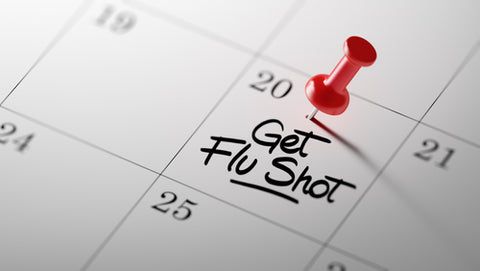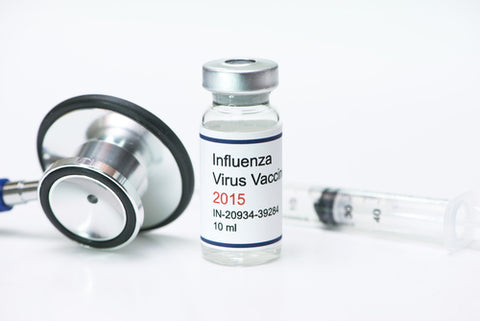Flu season is upon us. According to the Center for Disease Control (CDC), flu season runs rampant in the northern hemisphere from October to April of every year. Of course, the flu brings with it a host of misery, especially for someone who is unfortunate enough to catch it. Whether it’s the stuffy head, the sneezing, or the aches and sore throat, having the flu is a pain. Of course, according to the CDC, the best thing that you can do to keep from getting the flu is to get your annual flu shot.
Some people wonder why you need to get a flu shot every year. After all, with other illnesses caused by viruses – such as polio or smallpox – you only need one immunization in your life. The reason is that there are numerous types of flu and they are all changing and mutating every year. The combination that was in the flu shot last year likely will not be the most effective combination this year. You see, every year, the CDC and the World Health Organization (WHO) get together to predict what strain of the flu will run rampant that year. Once they make that prediction, they know what strains of flu to put into the shot.

When to Get the Flu Shot
You should get your flu shot as early in the season as you can. The flu shot starts to provide maximum protection about two weeks after you get your shot. Gradually, over time, this protection starts to fade, which is another reason why you need to get a new shot every year.

Can the Flu Shot Give You the Flu?
Many people worry that getting a flu shot is going to actually give them the flu. That’s not what happens at all. The flu shot uses dead flu viruses, so there’s no danger of you catching the flu. Still, you might hear someone tell of someone who got the flu shot and then got the flu shortly afterward. What likely happened is that the person was exposed to the flu virus and infected before the shot had time to become effective. Remember that it takes about two weeks after the initial shot for protection to maximize.
There are some side effects that people have reported when getting the flu shot. Most aren’t serious, however, and usually only last a day or two afterward. These side effects include a low-grade fever and slight soreness or redness around the injection site.
Of significantly more concern is if you exhibit an allergic reaction to the flu shot. While an allergy to the flu shot is rare, if you present any of the following symptoms, you should contact your doctor immediately:
- Difficulty breathing
- Dizziness or nausea
- A lot of swelling near the injection site
- Inability to walk or other weakness
- Hives
- Abnormally increased heart rate

What Are the Types of Flu Shot?
There are two types of flu shots that have been used in recent years. The first kind is injected with a small hypodermic needle and the second is the nasal spray. However, the nasal spray has become less effective in preventing the H1N1 flu in recent years. This led the CDC to stop recommending that doctors use it as a flu shot.
The injected flu shot comes in two forms – trivalent and quadrivalent – that protect against three and four individual strains respectively.
According to the CDC, the trivalent flu shot this year is designed to protect against the following strains:
- A/Michigan/45/2015 (H1N1) - PDM09-like virus
- A/Hong Kong/4801/2014 (H3N2)-like virus
- B/Brisbane/60/2008-like (B/Victoria lineage) virus
The quadrivalent flu shot protects against the same three strains as the trivalent, but adds protection against the following strain:
- B/Phuket/3073/2013-like (B/Yamagata lineage) virus

What Does the Flu Strain Name Mean?
It isn’t difficult to decipher the long string of letters and numbers that make up the name of a flu strain. For example, the A/Michigan/45/2015 (H1N1) strain is easily broken apart into five parts. The first part indicates that the primary strain of the flu is; in this case, it’s A. There are four separate strains – A, B, C, and D. D is a strain that only infects cows and has no history of infecting humans. C is a strain of the flu that has only ever caused mild infections of the throat and nose and has never been linked to a significant outbreak.
The other two are what cause all of the misery during the flu season. Influenza Type A is the notorious strain that is responsible for more deaths than the bubonic plague during the dark ages during the 1918 Spanish Flu outbreak. Other famous strains of the Type A flu include the Avian Flu pandemic in 2004, the H1N1 Swine Flu pandemic in 2009, and the Hong Kong Type A flu in 1968.
Type A is normally found in birds, but it can mutate so quickly that it will cross-infect humans and pigs with ease. This rapid mutation is also what makes getting an annual flu shot so necessary for proper protection.
Type B flu is only found in humans and mutates much less slowly than the Type A flu. This strain has also never been linked to any outbreaks in history.
The second part of the flu strain name indicates where the strain was first detected. In this case, it is Michigan. The next part is the individual strain number followed by the year that the flu was isolated. The last part in parentheses tells immunologists what the H and N combinations are for that particular strain. H and N refer to the proteins that make up the external part of the virus. Currently, only H1, H2, and H3, and N1 and N2 are known to infect humans.
In the end, the best thing you can do every flu season is to make an appointment with your doctor and get a flu shot. Remember, flu shots are usually free with medical insurance. And, getting your annual flu shot not only protects you, but it also helps protect those around you from getting sick as well.


